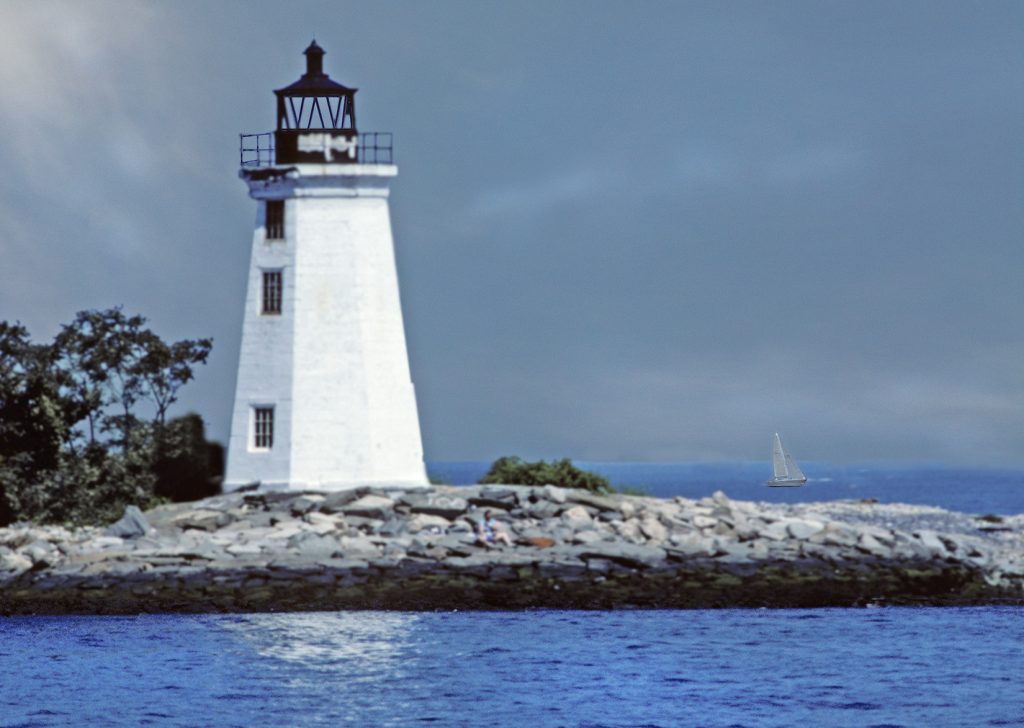Whether seen from just offshore or on nearby land, lighthouses, symbols of our navigational past, each have their own special appeal. Of all of the U. S. states, which one has the greatest number of lighthouses along its coast? That will be answered at the end of this article.
During the 1700s, Black Rock Harbor became the Port of Entry for Western Connecticut. Sheltered by Fayerweather Island, the harbor’s deep waters provided safe anchorage. The harbor had also evolved into a center for shipbuilding and production of carriages.

With the increasing importance of the harbor, the federal government in 1807, purchased Fayerweather Island and appropriated funds to erect a lighthouse. Built on a stone foundation, the octagonal wooden tower stood forty-feet high. Becoming operational in 1808, the tower’s lamps were at first suspended from chains that dropped from the lantern’s roof.
On September 1, 1821, an Atlantic hurricane struck the Turks and Caicos Islands. It then headed up the U. S. East Coast. It swept over North Carolina and then leveled the city of Norfolk, Virginia. On September 3, it struck New York City and Long Island Sound with winds ranging from 75 to 100 mph. Fayerweather Island Light’s oak and pine structure was ill-equipped for the storm. It soon gave way to the raging torrents.
Rebuilt in 1823, the contractor stated that the new structure was “prepared to withstand the storm of ages.” Edmond Blunt, publisher of the American Coast Pilot was not impressed. He reported, “…a more contemptible lighthouse does not disgrace Long Island Sound, most shamefully erected and badly kept.” Instead of using all stone inside the tower, the contractor used timbers inserted horizontally, placing them four feet apart. On later inspection, they were found to be in “…a state of decay.” Finally, in 1880, the tower’s defects were addressed, allowing the structure to survive as an attractive monument of coastal navigational aids.
Appointed on October 14, 1808, John Maltbee served as the lighthouse’s first keeper, but he died just five months later. Throughout its operational history, a total of nine keepers were assigned to Fayerweather Light. The best known of these keepers, Kate Moore, was the fifth to be appointed to the light.
Kathleen (Kate) was just four years old when her father, in 1817, was appointed keeper of the lighthouse. Gradually, a previous injury made it more and more difficult for him to perform all of the station’s duties. As was the case at most lights, his wife took on some of the work. However, by age 12, Kate was already performing many of the tasks beginning with trimming the wicks. At some point, she took on more lighthouse chores from her aging parents. Daily, she carried oil up the lighthouse’s steep steps, filled the lamps and monitored the beacon from the keeper’s dwelling.
During severe storms, Kate occasionally remained in the lighthouse tower to make sure that the beacon’s flame was not blown out. Storms were also a time to be on the lookout for vessels in distress. Sometimes accompanied by her brother, Kate headed out aboard the station’s small boat to carry out rescues in the local waters. Over time, she saved the lives of 21 mariners.
Kate never married. By 1871, her father was in his late 90s; she was 59 years old. During that year, she was appointed keeper of the Fayerweather Lighthouse. Along with the continued care for her parents, she also concerned herself with the family’s small herd of farm animals and a vegetable garden. Kate finally retired from the lighthouse in 1878. When she died around 1899, she was interred in a Bridgeport, Connecticut unmarked grave. However, in memory of her heroic service, the United States Coast Guard and the Bollinger Shipyards placed a marker on her grave on May 8, 2014. In addition, the USCG named one of their Fast-Response Cutters (FRC) Kathleen Moore. The 154-foot vessel was based out of Key West, Florida.
From Long Island Sound, getting to Fayerweather Island Lighthouse is easy. Proceeding just east of the Penfield Lighthouse, head northeast for approximately 1.5 miles. However, avoid an approach from the west side of Penfield Light, where shoals extend out from the shores of Fairfield, Connecticut. From land, the lighthouse can be reached from the western end of Barnum Boulevard at Seaside Park, Bridgeport, Connecticut. The light stands at the end of the breakwater at Seaside Park.
The United States had a total of about 1,000 lighthouses located along the coast of 37 states. Michigan with approximately150 lighthouses, hosted the greatest number of lighthouses in the nation. Maine comes in second with its still-standing 65 lighthouses.
